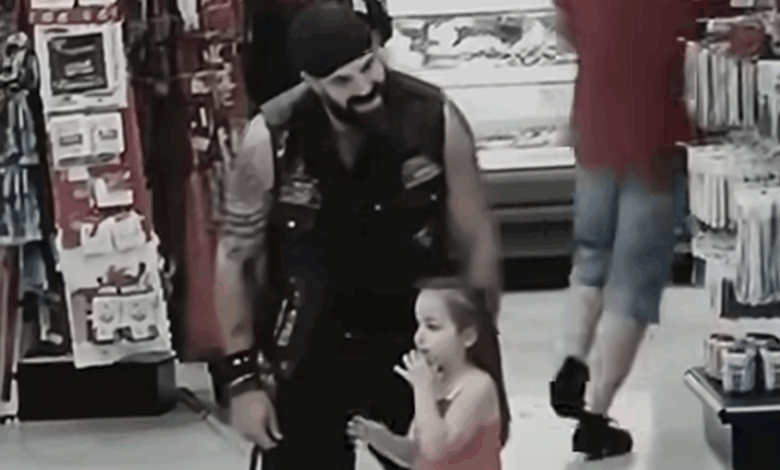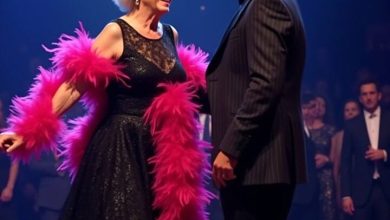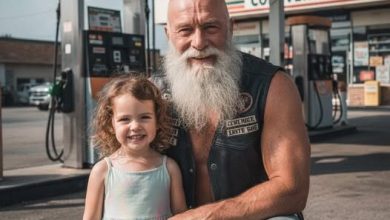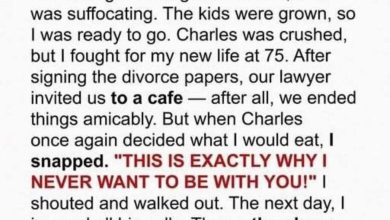
Unexpected Hero Biker Helps Mute Girl!
It was a quiet afternoon at Walmart when something extraordinary unfolded. Shoppers pushed carts down fluorescent aisles, children tugged at their parents’ sleeves, and the cashiers called out their usual greetings. Nothing hinted that within minutes, everyone present would witness a story they would retell for years.
A small six-year-old girl, wide-eyed and trembling, broke away from a distracted crowd near the checkout lanes. She ran with startling determination through the store, weaving between carts and startled adults until she stopped abruptly in front of a towering man. He was a biker—massive shoulders beneath a worn leather vest, arms inked with swirling tattoos, a beard that made his face look carved from stone. To the average onlooker, he was the kind of figure people instinctively avoided. Yet the little girl, mute and desperate, threw herself into his arms.
Gasps rippled through the store. Shoppers hesitated, unsure whether to intervene. The girl clung to the man’s vest as though her life depended on it, silent tears streaming down her cheeks. For a moment, the biker stood frozen, startled by the sudden embrace. Then, something unexpected happened.
His hands began to move. Not roughly, not clumsily—gracefully. He was signing, his fingers forming fluid shapes and gestures with surprising gentleness. The little girl looked up through her tears, and her expression transformed from terror to relief. They were speaking the same language.
The onlookers fell into stunned silence as the truth slowly emerged through their silent exchange. The girl’s name was Lucy. She hadn’t run at random; she had recognized a small patch stitched onto the biker’s vest—an emblem used within the deaf community to mark a “safe person,” someone trained to offer help and protection. That patch had given her courage.
With frantic movements, Lucy explained that she was in danger. The biker—later identified as a sign language teacher who had been riding with friends that afternoon—understood immediately. He crouched to meet her eyes, his signed words calm and deliberate, offering comfort no one else in the store could give.
Then his friends arrived. One by one, the bikers entered the store, their presence imposing. But instead of chaos, they created a circle of safety around Lucy and the man holding her. Leather vests and tattoos formed an unlikely barrier between the terrified child and whatever threat she had fled. Customers, who moments before had seen only intimidation, now witnessed protection in its purest form.
The manager called the authorities. Within minutes, officers stormed into the store, but instead of confusion, they found clarity. Lucy clung tightly to the biker’s arm, refusing to let go, until he began to translate her signs for the police. Patiently, he explained every detail she gave: she had been taken from her parents. She had escaped and was searching for someone who would understand her, someone she could trust. And she had found him.
The officers acted quickly. Calls went out, descriptions matched, and within the hour, the horrifying truth was confirmed. Lucy had indeed been abducted, and her parents had reported her missing. Thanks to her courage and the biker’s intervention, she was now safe.
When her parents arrived, the scene was one of overwhelming relief. Lucy ran into her mother’s arms, but not before pausing to squeeze the biker’s hand, her silent thank-you written across her tear-streaked face. Shoppers who had watched the drama unfold began to applaud. Some wiped their eyes. They had seen something rare—human connection cutting through fear and prejudice.
Later, Lucy’s parents explained that their daughter had known of the biker long before that day. During her early years of learning sign language, she had watched educational videos online—videos created by none other than the man she had run to. To her, he wasn’t a stranger at all. He was the one adult in that vast, noisy store she knew would understand her without words.
The story spread quickly, both in the town and across social media once witnesses began posting about it. Many marveled at the little girl’s bravery, others at the biker’s compassion, but the truth was simpler than that. At its heart, this was a story about trust—how a child recognized a symbol and chose to believe in it, and how a man who looked like the embodiment of menace revealed himself to be her safe harbor.
For the biker, it was never about heroism. When reporters later asked him why he had stepped in so quickly, he shrugged. “She asked for help,” he said. “When someone asks, you don’t walk away. Doesn’t matter who you are.”
But for Lucy and her family, he was far more than a passerby. He was the bridge between terror and safety, between silence and being heard. The man everyone feared at first glance had become the one person who could understand a child’s unspoken cry for help.
Back at Walmart, shoppers who had witnessed the scene found themselves reflecting on what they had seen. Some admitted they would have been too frightened to approach the biker before that day. Others confessed they had judged him before he even spoke. Yet all of them left the store with a story of compassion they would never forget.
Lucy returned home with her parents that night, clutching her favorite stuffed animal, the terror of her ordeal slowly giving way to safety. But she carried with her the memory of the stranger who hadn’t felt like a stranger at all—the man who spoke her language when no one else could.
And the biker? He returned to his life, to the roar of engines and the camaraderie of his brothers, but now with a patch of memory stitched deeper than any on his vest. He had been chosen by a child’s instinct, and in answering, he had proven that true strength is measured not in intimidation but in gentleness.
The story of Lucy and the biker became a quiet legend in that community—a reminder that heroes rarely look the way we expect them to. Sometimes, they ride Harleys, wear leather, and carry tattoos. Sometimes, they simply know how to listen when the rest of the world is deaf.




